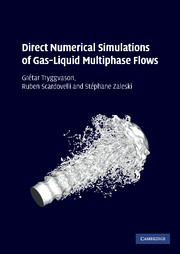Book contents
- Frontmatter
- Contents
- Preface
- 1 Introduction
- 2 Fluid mechanics with interfaces
- 3 Numerical solutions of the Navier–Stokes equations
- 4 Advecting a fluid interface
- 5 The volume-of-fluid method
- 6 Advecting marker points: front tracking
- 7 Surface tension
- 8 Disperse bubbly flows
- 9 Atomization and breakup
- 10 Droplet collision, impact, and splashing
- 11 Extensions
- Appendix A Interfaces: description and definitions
- Appendix B Distributions concentrated on the interface
- Appendix C Cube-chopping algorithm
- Appendix D The dynamics of liquid sheets: linearized theory
- References
- Index
11 - Extensions
Published online by Cambridge University Press: 07 October 2011
- Frontmatter
- Contents
- Preface
- 1 Introduction
- 2 Fluid mechanics with interfaces
- 3 Numerical solutions of the Navier–Stokes equations
- 4 Advecting a fluid interface
- 5 The volume-of-fluid method
- 6 Advecting marker points: front tracking
- 7 Surface tension
- 8 Disperse bubbly flows
- 9 Atomization and breakup
- 10 Droplet collision, impact, and splashing
- 11 Extensions
- Appendix A Interfaces: description and definitions
- Appendix B Distributions concentrated on the interface
- Appendix C Cube-chopping algorithm
- Appendix D The dynamics of liquid sheets: linearized theory
- References
- Index
Summary
Direct numerical simulations of multiphase flows are a rapidly growing field. In addition to continuous development of new and better numerical techniques and more extensive studies of the problems discussed so far in this Book, researchers are increasingly looking at new and more complex physical problems. In this chapter we examine briefly a few such extensions. We do not attempt to give an exhaustive list of all new applications of methods based on the “one-fluid” formulation of the fluid equations, but we hope that this introduction to the literature will be useful for our readers.
Additional fields and surface physics
Broadly speaking, new physics consists of new field equations, new surface effects, or both. Adding a new field is the simplest extension, but new fields often add new time- and length-scales. Mass transfer in liquids, for example, can lead to boundary layers that are much thinner than those resulting from either heat transfer or fluid motion. Resolving these boundary layers may introduce much more stringent resolution requirements than those necessary for the same problem in the absence of mass transfer.
The simplest new physics is probably heat transfer, where an advection/diffusion equation is solved for the temperature, and many authors have already studied multifluid problems involving heat transfer. The main complication is that large variations in the thermal conductivity across an interface can require fine grids and often it is better to use the harmonic mean of the conductivities at grid points where it is not defined, in the same way as for large differences in the viscosity (see Section 3.4).
Information
- Type
- Chapter
- Information
- Direct Numerical Simulations of Gas–Liquid Multiphase Flows , pp. 243 - 269Publisher: Cambridge University PressPrint publication year: 2011
